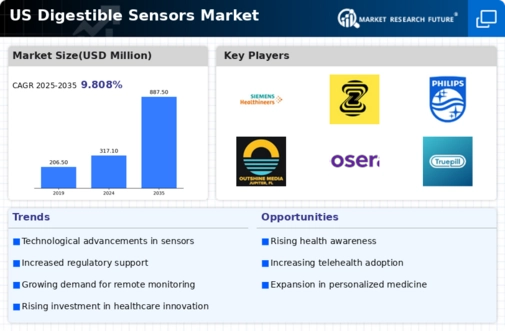Increasing Prevalence of Chronic Diseases
The rising incidence of chronic diseases in the US is a pivotal driver for the digestible sensors market. Conditions such as diabetes, cardiovascular diseases, and gastrointestinal disorders necessitate continuous monitoring of patients' health metrics. The digestible sensors market is poised to benefit from this trend, as these sensors provide real-time data that can help in managing these conditions effectively. According to recent estimates, chronic diseases account for approximately 75% of healthcare spending in the US, highlighting the urgent need for innovative monitoring solutions. As healthcare providers seek to enhance patient outcomes while reducing costs, the adoption of digestible sensors is likely to increase, thereby propelling market growth. This trend underscores the importance of integrating advanced monitoring technologies into chronic disease management strategies.
Advancements in Digital Health Technologies
The rapid evolution of digital health technologies is significantly influencing the digestible sensors market. Innovations in telemedicine, mobile health applications, and wearable devices are creating a conducive environment for the adoption of digestible sensors. These technologies facilitate seamless data transmission and analysis, allowing healthcare providers to monitor patients remotely. The digestible sensors market is expected to see substantial growth as these technologies become more integrated into healthcare systems. Market data suggests that the digital health market in the US is projected to reach $500 billion by 2025, indicating a robust demand for innovative health monitoring solutions. This convergence of digital health and sensor technology is likely to enhance patient engagement and improve health outcomes, further driving the market.
Growing Consumer Awareness of Health Monitoring
Consumer awareness regarding the importance of health monitoring is on the rise, which serves as a significant driver for the digestible sensors market. As individuals become more health-conscious, there is an increasing demand for tools that facilitate proactive health management. The digestible sensors market is likely to benefit from this trend, as these sensors offer a non-invasive method for monitoring various health parameters. Market Research Future indicates that nearly 60% of consumers in the US are interested in using technology to manage their health, suggesting a strong market potential. This heightened awareness is prompting healthcare providers to incorporate digestible sensors into their offerings, thereby enhancing patient engagement and adherence to treatment plans. The growing emphasis on personalized healthcare solutions further supports the expansion of this market.
Regulatory Support for Innovative Medical Devices
Regulatory bodies in the US are increasingly supportive of innovative medical devices, which is a crucial driver for the digestible sensors market. The Food and Drug Administration (FDA) has streamlined approval processes for novel health technologies, encouraging the development and commercialization of digestible sensors. This regulatory environment fosters innovation and instills confidence among manufacturers and investors. The digestible sensors market stands to gain from this trend, as faster approval times can lead to quicker market entry for new products. Furthermore, the FDA's emphasis on patient safety and efficacy ensures that only high-quality devices reach consumers, which can enhance market growth. As regulatory frameworks continue to evolve, the potential for new entrants and advancements in sensor technology is likely to expand.
Integration of Artificial Intelligence in Healthcare
The integration of artificial intelligence (AI) in healthcare is emerging as a transformative driver for the digestible sensors market. AI technologies enable advanced data analytics, which can enhance the functionality and effectiveness of digestible sensors. By leveraging AI, healthcare providers can gain deeper insights from the data collected by these sensors, leading to more informed decision-making. The digestible sensors market is likely to experience growth as AI applications become more prevalent in health monitoring. Current estimates suggest that the AI in healthcare market is expected to reach $36 billion by 2025, indicating a robust investment in this area. This synergy between AI and digestible sensors could lead to improved patient outcomes and more efficient healthcare delivery, further propelling market expansion.






















Leave a Comment